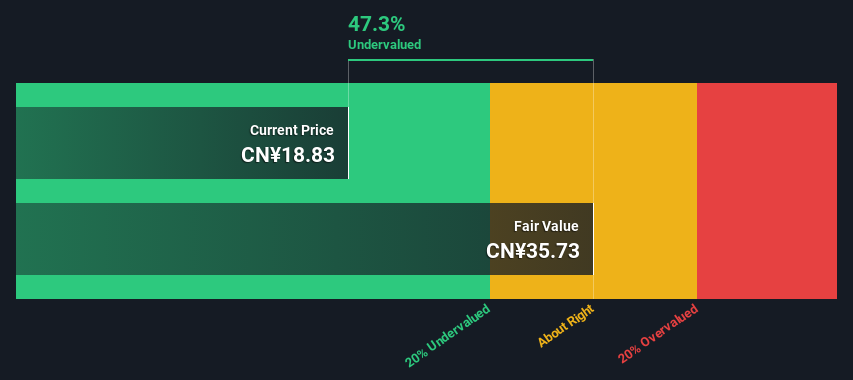- China
- /
- Semiconductors
- /
- SHSE:688599
An Intrinsic Calculation For Trina Solar Co., Ltd. (SHSE:688599) Suggests It's 47% Undervalued

Key Insights
- Using the 2 Stage Free Cash Flow to Equity, Trina Solar fair value estimate is CN¥35.73
- Trina Solar's CN¥18.83 share price signals that it might be 47% undervalued
- Analyst price target for 688599 is CN¥21.63 which is 39% below our fair value estimate
Does the September share price for Trina Solar Co., Ltd. (SHSE:688599) reflect what it's really worth? Today, we will estimate the stock's intrinsic value by projecting its future cash flows and then discounting them to today's value. The Discounted Cash Flow (DCF) model is the tool we will apply to do this. There's really not all that much to it, even though it might appear quite complex.
We generally believe that a company's value is the present value of all of the cash it will generate in the future. However, a DCF is just one valuation metric among many, and it is not without flaws. For those who are keen learners of equity analysis, the Simply Wall St analysis model here may be something of interest to you.
View our latest analysis for Trina Solar
The Method
We use what is known as a 2-stage model, which simply means we have two different periods of growth rates for the company's cash flows. Generally the first stage is higher growth, and the second stage is a lower growth phase. To start off with, we need to estimate the next ten years of cash flows. Where possible we use analyst estimates, but when these aren't available we extrapolate the previous free cash flow (FCF) from the last estimate or reported value. We assume companies with shrinking free cash flow will slow their rate of shrinkage, and that companies with growing free cash flow will see their growth rate slow, over this period. We do this to reflect that growth tends to slow more in the early years than it does in later years.
A DCF is all about the idea that a dollar in the future is less valuable than a dollar today, so we need to discount the sum of these future cash flows to arrive at a present value estimate:
10-year free cash flow (FCF) forecast
| 2025 | 2026 | 2027 | 2028 | 2029 | 2030 | 2031 | 2032 | 2033 | 2034 | |
| Levered FCF (CN¥, Millions) | CN¥1.56b | CN¥2.26b | CN¥4.19b | CN¥5.83b | CN¥7.48b | CN¥9.03b | CN¥10.4b | CN¥11.6b | CN¥12.7b | CN¥13.6b |
| Growth Rate Estimate Source | Analyst x1 | Analyst x1 | Analyst x1 | Est @ 39.27% | Est @ 28.34% | Est @ 20.70% | Est @ 15.34% | Est @ 11.59% | Est @ 8.97% | Est @ 7.13% |
| Present Value (CN¥, Millions) Discounted @ 13% | CN¥1.4k | CN¥1.8k | CN¥2.9k | CN¥3.6k | CN¥4.1k | CN¥4.4k | CN¥4.5k | CN¥4.4k | CN¥4.3k | CN¥4.1k |
("Est" = FCF growth rate estimated by Simply Wall St)
Present Value of 10-year Cash Flow (PVCF) = CN¥35b
After calculating the present value of future cash flows in the initial 10-year period, we need to calculate the Terminal Value, which accounts for all future cash flows beyond the first stage. For a number of reasons a very conservative growth rate is used that cannot exceed that of a country's GDP growth. In this case we have used the 5-year average of the 10-year government bond yield (2.9%) to estimate future growth. In the same way as with the 10-year 'growth' period, we discount future cash flows to today's value, using a cost of equity of 13%.
Terminal Value (TV)= FCF2034 × (1 + g) ÷ (r – g) = CN¥14b× (1 + 2.9%) ÷ (13%– 2.9%) = CN¥140b
Present Value of Terminal Value (PVTV)= TV / (1 + r)10= CN¥140b÷ ( 1 + 13%)10= CN¥42b
The total value is the sum of cash flows for the next ten years plus the discounted terminal value, which results in the Total Equity Value, which in this case is CN¥77b. In the final step we divide the equity value by the number of shares outstanding. Relative to the current share price of CN¥18.8, the company appears quite good value at a 47% discount to where the stock price trades currently. Valuations are imprecise instruments though, rather like a telescope - move a few degrees and end up in a different galaxy. Do keep this in mind.

The Assumptions
We would point out that the most important inputs to a discounted cash flow are the discount rate and of course the actual cash flows. If you don't agree with these result, have a go at the calculation yourself and play with the assumptions. The DCF also does not consider the possible cyclicality of an industry, or a company's future capital requirements, so it does not give a full picture of a company's potential performance. Given that we are looking at Trina Solar as potential shareholders, the cost of equity is used as the discount rate, rather than the cost of capital (or weighted average cost of capital, WACC) which accounts for debt. In this calculation we've used 13%, which is based on a levered beta of 2.000. Beta is a measure of a stock's volatility, compared to the market as a whole. We get our beta from the industry average beta of globally comparable companies, with an imposed limit between 0.8 and 2.0, which is a reasonable range for a stable business.
SWOT Analysis for Trina Solar
- Debt is well covered by earnings and cashflows.
- Dividend is in the top 25% of dividend payers in the market.
- Earnings declined over the past year.
- Annual earnings are forecast to grow faster than the Chinese market.
- Good value based on P/E ratio and estimated fair value.
- Dividends are not covered by cash flow.
- Annual revenue is forecast to grow slower than the Chinese market.
Looking Ahead:
Although the valuation of a company is important, it is only one of many factors that you need to assess for a company. It's not possible to obtain a foolproof valuation with a DCF model. Rather it should be seen as a guide to "what assumptions need to be true for this stock to be under/overvalued?" If a company grows at a different rate, or if its cost of equity or risk free rate changes sharply, the output can look very different. Can we work out why the company is trading at a discount to intrinsic value? For Trina Solar, we've compiled three pertinent elements you should look at:
- Risks: For example, we've discovered 4 warning signs for Trina Solar that you should be aware of before investing here.
- Future Earnings: How does 688599's growth rate compare to its peers and the wider market? Dig deeper into the analyst consensus number for the upcoming years by interacting with our free analyst growth expectation chart.
- Other Solid Businesses: Low debt, high returns on equity and good past performance are fundamental to a strong business. Why not explore our interactive list of stocks with solid business fundamentals to see if there are other companies you may not have considered!
PS. Simply Wall St updates its DCF calculation for every Chinese stock every day, so if you want to find the intrinsic value of any other stock just search here.
Valuation is complex, but we're here to simplify it.
Discover if Trina Solar might be undervalued or overvalued with our detailed analysis, featuring fair value estimates, potential risks, dividends, insider trades, and its financial condition.
Access Free AnalysisHave feedback on this article? Concerned about the content? Get in touch with us directly. Alternatively, email editorial-team (at) simplywallst.com.
This article by Simply Wall St is general in nature. We provide commentary based on historical data and analyst forecasts only using an unbiased methodology and our articles are not intended to be financial advice. It does not constitute a recommendation to buy or sell any stock, and does not take account of your objectives, or your financial situation. We aim to bring you long-term focused analysis driven by fundamental data. Note that our analysis may not factor in the latest price-sensitive company announcements or qualitative material. Simply Wall St has no position in any stocks mentioned.
About SHSE:688599
Trina Solar
Engages in the research and development, production, and sales of photovoltaic (PV) modules in China, Europe, North America, South America, Japan, the Asia Pacific, the Middle East, and North Africa.
Fair value with moderate growth potential.
Similar Companies
Market Insights
Community Narratives



